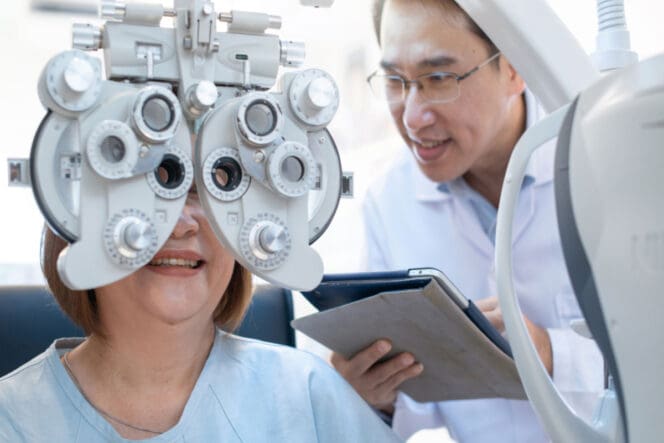Recognizing the Role of Your Eye Doctor in Keeping Vision
Recognizing the Role of Your Eye Doctor in Keeping Vision
Blog Article
Discovering the Latest Technological Advancements in Optometry and What They Mean for Optometrists
In the ever-evolving field of optometry, current technological improvements are improving exactly how practitioners come close to eye treatment. From the accuracy of Optical Coherence Tomography to the nuanced understandings used by AI-driven analysis tools, these developments are setting brand-new requirements in client analysis and therapy. Teleoptometry is positioned to redefine availability, guaranteeing that proficiency transcends geographical limitations. As these developments permeate the method, eye doctors are confronted with the challenge of embracing these devices to enhance patient end results. The inquiry stays: how will these technological shifts redefine the functions and duties within the occupation?
Innovations in Diagnostic Tools
Progressing the area of optometry, developments in analysis devices have actually reinvented the way eye care professionals examine and detect visual impairments and eye problems. The previous years has seen significant technological innovations, enabling even more thorough and exact evaluations.
One more trick advancement is the introduction of advanced corneal topography systems, which map the surface area curvature of the cornea with accuracy. These devices are specifically useful for fitting call lenses and identifying corneal problems. Electronic retinal imaging has actually changed traditional ophthalmoscopy, providing in-depth, breathtaking views of the retina that promote extensive visual examinations.
The development of wavefront aberrometry has actually also been important, making it possible for the evaluation of refractive mistakes with unmatched precision (Eye Doctor). This innovation assists in personalizing rehabilitative lenses and improving medical end results for refractive surgical treatments. Collectively, these analysis advancements equip optometrists to provide exceptional individual care, making sure very early treatment and tailored therapy methods, inevitably enhancing aesthetic health results
AI in Patient Monitoring
Structure on the structure of advanced analysis tools, the consolidation of man-made knowledge (AI) in client monitoring represents a transformative jump for optometry. AI systems are increasingly used to enhance efficiency, accuracy, and customization in individual treatment.
Furthermore, AI-driven platforms facilitate streamlined person communications and management procedures. Automated scheduling, online assessments, and customized follow-up plans not only boost person contentment but likewise optimize time management for professionals. These systems can triage individuals based on the urgency of their conditions, guaranteeing that those in important need obtain prompt focus.
Moreover, AI enhances decision-making by supplying eye doctors with evidence-based suggestions and therapy paths. By incorporating information from electronic health documents, AI tools supply understandings that notify clinical choices, reducing the risk of errors and enhancing individual results. As AI remains to advance, its role in client administration will likely broaden, reshaping the landscape of optometric treatment.
Advancements in Retinal Imaging
In the world of optometry, retinal imaging has experienced impressive technological improvements that are enhancing analysis capacities and person treatment. Advancements such as Optical Coherence Tomography (OCT) and fundus digital photography have transformed exactly how optometrists picture and examine the retina.
Boosted imaging techniques like OCT angiography are further refining analysis precision. Optometrist Chino. Such innovations assist in the identification of minute retinal changes that could indicate condition progression.
Furthermore, improvements in artificial knowledge are increasing retinal imaging by making it possible for computerized evaluation of huge datasets. These systems aid eye doctors in recognizing patterns indicative of pathology, therefore improving diagnostic precision and efficiency. Jointly, these innovations are changing retinal imaging right into a cornerstone of modern-day eye treatment, improving outcomes and broadening restorative possibilities.
Teleoptometry's Expanding Function
Teleoptometry is progressively becoming a vital component of eye treatment, driven by advancements in data and diagnostic tools. As optometry embraces electronic change, teleoptometry promotes remote examinations, permitting click for more eye doctors to prolong their services past conventional limits. This is specifically useful in rural and underserved areas where access to specialized eye care is typically minimal. By leveraging high-resolution video conferencing and advanced retinal imaging, eye doctors can conduct extensive eye exams from afar, making sure timely diagnosis and therapy.
The integration of fabricated knowledge (AI) further boosts teleoptometry, making it possible for the analysis of aesthetic data and aiding in the discovery of ocular problems such as glaucoma and diabetic retinopathy. AI-powered algorithms can rapidly analyze intricate imaging data, providing eye doctors with valuable understandings that reinforce clinical decision-making.
Furthermore, teleoptometry sustains continuity of treatment through smooth combination with digital wellness documents (EHRs), allowing eye doctors to preserve comprehensive person histories. This guarantees that individuals obtain constant and personalized treatment also when seeking advice from different specialists.
Regardless of these benefits, obstacles remain, consisting of making certain data safety and taking care of person assumptions. Teleoptometry stands for a considerable stride towards more accessible, reliable, and patient-centered eye care. As innovation develops, its duty is poised to expand additionally.

Future Patterns in Eye Care
A myriad of innovative trends is readied to reshape the future of eye care, driven by technological developments and the advancing demands of individuals. One substantial pattern is the integration of expert system (AI) in diagnostics, which assures to enhance the precision redirected here and performance of eye exams. AI formulas can evaluate substantial quantities of information from retinal photos, potentially identifying problems like diabetic retinopathy and glaucoma earlier than conventional methods.
Moreover, tailored medicine is acquiring grip in optometry, with hereditary screening educating tailored therapy plans. This approach intends to optimize client end results by customizing interventions to individual genetic profiles. Wearable technology, such as wise call lenses, is also on the perspective, using real-time tracking of intraocular stress or glucose degrees, therefore giving continual insights right into ocular and systemic health.
The adoption of augmented truth (AR) and virtual fact (VIRTUAL REALITY) in training and client education is another emerging pattern. These technologies use immersive experiences that can enhance understanding and abilities both for optometrists and people. As these patterns develop, optometrists should remain abreast of technological innovations to give innovative treatment, making sure enhanced patient results and satisfaction in get redirected here the dynamic landscape of eye care.
Conclusion

Collectively, these diagnostic advancements empower optometrists to supply remarkable client care, guaranteeing very early treatment and customized treatment approaches, eventually enhancing visual health and wellness results.

As these innovations proceed to advance, eye doctors have to adjust and integrate them into technique, ultimately maximizing operations efficiency and raising the standard of eye treatment supplied to individuals.
Report this page